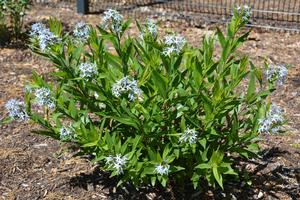Printed at http://www.newmoonnursery.com/index.cfm/

Bluestar is suitable for use in rain gardens, ornamental landscapes, and for attracting pollinators.
Amsonia tabernaemontana v. salicifolia
Willow leaf Bluestar
Native to North America
FIRST IMPRESSIONS: Like Eastern Bluestar, Willow Bluestar has a striking growth habit, clean attractive foliage and pale blue starry flowers. Plants develop a handsome shrub-like form with dense growth and yellow fall color. This resilient native is adaptable to most garden situations and is tough enough to require almost no maintenance.
HABITAT & HARDINESS: Willow Bluestar is native as far north as Illinois and south to Texas. It is hardy from USDA Zones 3-9 in moist sloped woodlands and floodplain forests.
This Bluestar is classified by USDA-Plants as a facultative wetland plant but in cultivation it does well in average to moist soil.
PLANT DESCRIPTION: Willow Bluestar is a sturdy warm season perennial. Plants have a lovely vase-shaped growth habit that becomes more striking with age. Mature plants average 3’ tall and 3’ wide
Mature foliage is dark green, narrow and willow like. Blooms are lavender blue and star shaped. Autumn foliage is tinted in a lovely clear yellow shade.
Plants are particularly beautiful during the spring transition. Leaves are lime green as they emerge. As the leaves attain full size, clusters of deep blue pointed flower buds appear and unfurl into star shaped florets.
CULTURAL & MAINTENANCE NEEDS: Willow Bluestar is very adaptable and easy to grow. It tolerates moist sandy to heavy clay soils and is drought tolerant once established. Plants will also thrive in certain types of wetlands.
Plants thrive in sun to part sun but also do well in very little direct sun. In dense shade, stems can become weak and floppy. If flopping occurs, plants can be pruned back so that stronger shorter stems can develop.
Willow Bluestar is unpalatable to insect pests and foraging herbivores like deer and rabbits. Ruby throated hummingbirds, large carpenter bees, hummingbird moths and butterflies seek the floral nectar.
LANDSCAPE USES: Tidy foliage and a striking vase shaped growth habit allow this Bluestar to perform well as an Accent plant. It can also be used as a Butterfly Nectar Plant or as part of a Group or Mass. Plants inject seasonal interest (Fall Color and Showy Blooms) into the garden and are valuable components of Cottage Gardens, Deer Resistant Plantings, Water-wise Landscapes, Low Maintenance Plantings, Meadow or Prairie Gardens, Perennial Borders, Shade Gardens, Wetlands and Wildlife Gardens.
COMPANION & UNDERSTUDY PLANTS: Willow Bluestar blooms coincide with those of meadow phlox, false indigo and beard tongue. The golden fall foliage is attractive with fall asters like ‘Raydon’s Favorite.
Other amsonias like the closely related Eastern Bluestar can be substituted if this one is not available.
TRIVIA: Richard T. Hawke of the Chicago Botanic Garden conducted a comparative study of 11 taxa of hardy amsonias. Amsonia tabernaemontana var. salicifolia was one of the two with the highest rankings. According to the study, this species “…received excellent ratings because of high flower production, superior habit, good health and winter hardiness.”
Amsonia is a member of the Dogbane Family (Apocynaceae). Most family members like the infamous oleander have milky or viscous sap that can be loaded with highly toxic alkaloids. The Bluestars’ latex sap is mildly irritating and not considered to be harmful to humans. It does make the plant unappealing to foraging rabbits, deer, insects and slugs and other garden pests. The adaptable coral hairstreak butterfly caterpillar, however, uses this Amsonia as a host plant.
Height:
3 ftSpread:
2-3 ftUSDA Hardiness Zone:
3-9Bloom Color:
BlueAmsonia tabernaemontana v. salicifolia Characteristics
Attracts Wildlife
- Butterflies
Attributes
- Dried Flower
- Cut Flower
- Clay Soil
Exposure
- Partial Shade to Full Sun
Deer Resistant
- Deer Resistant
Flowering Months
- June
- May
Foliage Color
- Green
Soil Moisture Preference
- Moist
Interesting Notes:
For more information on this plant, visit the USDA PLANTS Database: http://plants.usda.gov/java/profile?symbol=AMTAS
